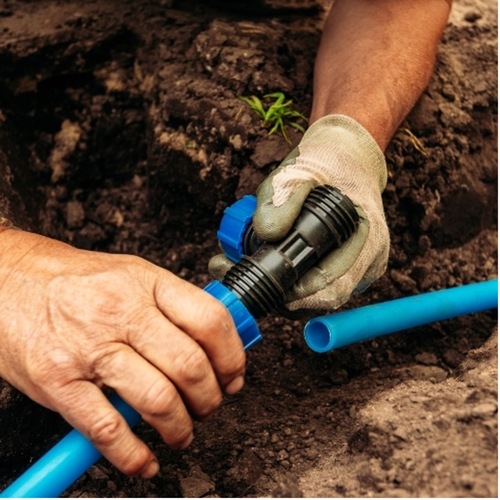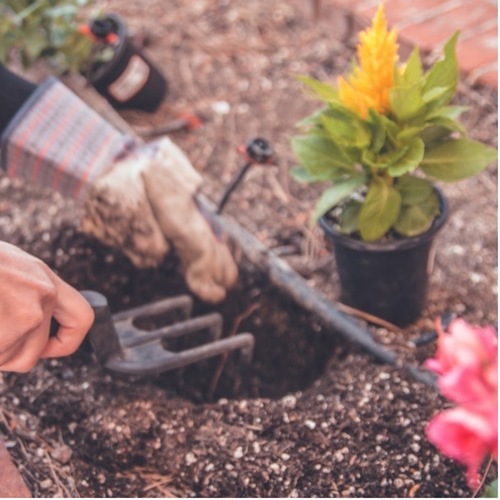To-Do List: March Gardening
March Gardening To-Do List: Preparing Your Garden for Spring
As the spring season unfolds and you find yourself with some extra time at home, it’s crucial to ensure that your garden and landscaping are prepared for the upcoming weather changes. Here, we provide a comprehensive guide to the essential tasks you should tackle this March to set your garden up for success.
Repot Houseplants for Optimal Growth

Houseplants Being Watered – Photo by Cassidy Phillips on Unsplash
March presents an ideal opportunity to transplant your houseplants into larger pots with fresh soil. This is beneficial for both indoor plants and those destined for outdoor placement. Here’s why repotting is essential and how you can do it effectively:
Importance of Repotting Houseplants
- Nutrient Refresh: Over time, the nutrients in potting soil become depleted as plants absorb them for growth. Repotting replenishes these nutrients, providing a fresh supply for healthy development.
- Root Space: As houseplants grow, their roots outgrow their containers, becoming root-bound. Repotting offers ample space for root expansion, preventing overcrowding and promoting robust root systems.
- Improved Drainage: Old potting soil can become compacted, leading to poor drainage and waterlogging. Repotting ensures proper drainage, reducing the risk of root rot and other moisture-related issues.
Signs It’s Time to Repot
- Root-Bound : If you notice roots circling the pot’s edges or emerging from drainage holes, it’s a clear sign that your plant needs a larger container.
- Slow Growth: Stunted growth or yellowing leaves despite adequate care can indicate that the plant has outgrown its current pot and needs more space.
- Watering Challenges: Plants requiring frequent watering or showing signs of water stress may benefit from a larger pot with improved soil moisture retention.
How to Repot Houseplants
- Choose the Right Pot : Select a container that is 1-2 inches larger in diameter than the current pot and has drainage holes to prevent waterlogging.
- Prepare Fresh Soil: Use high-quality potting mix suitable for your plant type, ensuring it’s well-draining and nutrient rich.
- Gently Remove the Plant: Carefully loosen the plant from its current pot, teasing out any tangled roots without causing damage.
- Add Soil and Reposition: Place a layer of fresh soil in the new pot, position the plant at the same depth as before, and fill in around the roots with more soil.
- Water and Settle: Thoroughly water the plant after repotting to help settle the soil and hydrate the roots. Allow excess water to drain away.
- Post-Repotting Care: Place the plant in a suitable location with appropriate light and temperature conditions. Avoid fertilizing immediately after repotting to allow the plant to adjust.
Pruning Tips for Houseplants
In addition to repotting, March is an excellent time to prune your houseplants for optimal growth and aesthetics. Here are some pruning tips to keep in mind:
- Remove Dead or Yellowing Foliage: Trim away any dead, yellow, or damaged leaves to maintain a tidy appearance and encourage new growth.
- Control Size: Pruning helps manage the size and shape of your plants, preventing them from becoming too leggy or sprawling.
- Encourage Bushier Growth: Pinch back the tips of stems to promote branching and denser foliage, creating a fuller and more attractive plant.
Check and Maintain Irrigation Systems

An Irrigation System Receives a Spring Checkup
As the spring season approaches, it’s essential to ensure that your garden’s irrigation system is in optimal condition. Proper maintenance not only conserves water but also promotes healthy plant growth. Here’s a detailed look at why checking and maintaining your irrigation system is crucial and how you can do it effectively:
Importance of Checking Irrigation Systems
- Efficient Watering: An efficient irrigation system delivers water precisely where and when plants need it, preventing overwatering or underwatering issues.
- Plant Health: Consistent and adequate moisture levels support plant health, reducing stress and susceptibility to pests and diseases.
- Water Conservation: Regularly maintaining your irrigation system minimizes water wastage, contributing to environmental sustainability and lower water bills.
Signs of Irrigation System Issues
- Uneven Watering: Areas of your garden receiving too much or too little water compared to others indicates potential irrigation system problems.
- Leaks or Breaks: Check for leaks, broken sprinkler heads, or damaged hoses that can lead to water loss and inefficient watering.
- Clogged Nozzles: Inspect spray nozzles for clogs or obstructions that can disrupt water distribution patterns.
How to Check and Maintain Irrigation Systems
- Inspect Sprinkler Heads: Walk around your garden and observe each sprinkler head’s performance. Look for misaligned or clogged heads that need adjustment or cleaning.
- Check for Leaks: Examine hoses, connectors, and drip lines for leaks or signs of water seepage. Repair or replace damaged components promptly.
- Test Coverage: Turn on your irrigation system and check the spray pattern to ensure uniform coverage without dry spots or excessive runoff.
- Adjust Timers: Review and adjust irrigation timers based on seasonal water requirements. Consider using smart controllers for automated and efficient watering schedules.
- Clean Filters: Clean or replace filters in drip irrigation systems to prevent clogs and ensure proper water flow.
- Inspect Valve Boxes: Check valve boxes for any debris, dirt, or damage that may affect valve operation. Clean and repair as needed.
- Monitor Soil Moisture: Use moisture sensors or manually check soil moisture levels to determine if adjustments to watering schedules are necessary.
Benefits of Regular Irrigation System Maintenance
- Optimal Plant Growth: Well-maintained irrigation systems provide plants with the right amount of water, promoting healthy growth and lush landscapes.
- Water Efficiency: Efficient irrigation practices reduce water waste and conserve this valuable resource, benefiting both your garden and the environment.
- Cost Savings: By addressing issues promptly and maintaining your system, you can avoid costly repairs and excessive water bills.
For intricate irrigation systems, or if you’re unsure about maintenance tasks, consider consulting with a professional landscaper. They can conduct comprehensive assessments, perform repairs or upgrades, and provide tailored watering solutions for your garden’s specific needs.
Clear Out Flower Beds for Spring Blooms

A Flower Bed Being Mulched
Preparing your flower beds for the upcoming spring blooms is a crucial step in ensuring a vibrant and healthy garden. Clearing out debris and making way for new growth sets the stage for a stunning floral display . Here’s why clearing out flower beds is essential and how you can do it effectively:
Importance of Clearing Flower Beds
- Promotes Growth: Removing debris such as old mulch, wet leaves, and dead plants allows sunlight and nutrients to reach the soil, encouraging new growth.
- Prevents Disease: Eliminating decaying organic matter reduces the risk of fungal diseases and pests that thrive in damp, cluttered environments.
- Enhances Aesthetic Appeal: A tidy and well-maintained flower bed enhances the overall appearance of your garden, creating a welcoming and visually pleasing outdoor space.
Signs It’s Time to Clear Flower Beds
- Winter Debris: Look for accumulated leaves, twigs, and other organic matter that may have built up over the winter months.
- Dead Plant Material: Remove any dead or decaying plant material, including annuals that didn’t survive the winter, to make room for new plantings.
- Mulch Renewal: If your mulch has decomposed or become matted, it’s time to rake it away and add fresh mulch for insulation and weed suppression.
How to Clear Flower Beds
- Rake Away Debris: Use a garden rake to gently remove leaves, twigs, and other debris from the surface of the soil. Be careful not to disturb emerging bulbs or perennials.
- Remove Dead Plants: Pull out any dead annuals or perennials that didn’t survive the winter. Cut back dead foliage on perennials to encourage new growth.
- Refresh Mulch : If necessary, add a layer of fresh mulch to the flower bed. Mulch helps retain moisture, suppress weeds, and regulate soil temperature.
- Inspect Soil: Take this opportunity to inspect the soil for compaction or drainage issues. Loosen compacted soil and amend it with organic matter if needed.
- Prune Shrubs and Trees: Trim back overgrown shrubs and trees to maintain a tidy appearance and encourage healthy growth.
- Plan for Spring Plantings: After clearing the flower bed, plan your spring plantings based on sunlight requirements, plant height, and color schemes for a cohesive and balanced look.
Benefits of Clearing Flower Beds
- Healthy Soil: Clearing debris and adding fresh mulch replenishes soil nutrients and improves soil structure, supporting healthy plant growth.
- Reduced Pest and Disease Risk: Removing potential hiding spots for pests and eliminating disease-prone material reduces the risk of infestations and infections.
- Enhanced Visual Impact: A clean and well-maintained flower bed creates a focal point in your garden, showcasing the beauty of your plants and flowers.
Planting Annual Flowers for Vibrant Displays

Soil is Prepped for Spring Flower Planting – Photo by Kenny Eliason on Unsplash
March marks the perfect time to introduce colorful annual flowers into your garden, adding vibrancy and charm to outdoor spaces. Planting annuals not only brightens up your landscape but also provides ongoing blooms throughout the season. Here’s why planting annual flowers is beneficial and how you can create stunning displays:
Benefits of Planting Annual Flowers
- Continuous Blooms: Annual flowers, unlike perennials, bloom continuously throughout the growing season, ensuring a constant display of colors and textures in your garden.
- Seasonal Variety: With a wide range of annuals available, you can choose plants that thrive in your climate and create diverse color palettes to suit your preferences.
- Filler and Accent Plants: Annuals serve as excellent filler and accent plants in flower beds, containers, and borders, enhancing visual interest and complementing other garden features.
Choosing the Right Annuals
- Climate Considerations : Select annuals that are well suited to your local climate, taking into account factors such as temperature, sunlight exposure, and water requirements.
- Color Coordination: Plan your plantings based on color schemes to create harmonious and eye-catching arrangements. Consider contrasting or complementary colors for visual impact.
- Height and Growth Habit: Pay attention to the mature height and growth habits of annuals to ensure they fit well within your garden layout and don’t overshadow other plants.
Planting Techniques for Annual Flowers
- Prepare the Soil: Ensure the planting area has well-draining soil enriched with compost or organic matter to provide nutrients for healthy growth.
- Spacing and Layout: Follow recommended spacing guidelines for each type of annual to allow sufficient room for growth and prevent overcrowding.
- Planting Depth: Dig holes slightly larger than the root ball of each annual plant and plant them at the same depth as they were in their containers.
- Watering and Mulching: Water newly planted annuals thoroughly, and apply a layer of mulch to conserve moisture, suppress weeds, and maintain soil temperature.
- Fertilization: Depending on the specific needs of your chosen annuals, consider applying a balanced fertilizer to promote strong root development and prolific flowering.
Frost Protection for Early Plantings
If your region still experiences occasional frosts in March, be prepared to protect newly planted annuals from cold damage. Use frost cloths or covers to shield plants overnight, and remove them during the day to allow sunlight and air circulation.
Long-Term Care Tips
- Deadheading: Regularly remove spent flowers (deadheading) to encourage continuous blooming and maintain a tidy appearance.
- Watering Schedule: Establish a consistent watering schedule, ensuring that annuals receive adequate moisture without becoming waterlogged.
- Pest and Disease Management: Monitor plants for pests and diseases, and take appropriate measures such as using insecticidal soap or organic treatments as needed.
Creating Stunning Displays with Annual Flowers
Consider incorporating various annuals with different bloom times, heights, and colors to create dynamic and visually appealing displays. Mix trailing varieties for container arrangements, border edges, or hanging baskets, while taller annuals can serve as focal points in flower beds or garden borders.
Consider Professional Assistance for Comprehensive Care

Plant Healthcare Management with Arborist Now
While many gardening tasks can be tackled independently, certain aspects of garden maintenance and landscaping may benefit from professional expertise. Considering professional assistance ensures comprehensive care for your outdoor space, addressing complex issues and enhancing the overall health and beauty of your garden. Here’s why consulting with landscaping professionals is beneficial and how they can assist you:
Benefits of Professional Assistance
- Expertise and Experience: Landscaping professionals bring in-depth knowledge and years of experience, allowing them to assess your garden’s unique needs and provide effective solutions.
- Time Saving: Outsourcing tasks such as tree pruning , hardscaping installations , or irrigation system upgrades saves you time and effort, allowing you to enjoy your garden without the stress of extensive maintenance.
- Customized Solutions: Professionals offer tailored solutions based on your garden’s size, layout, plant species, soil conditions, and climate, ensuring optimal care and sustainability.
- Access to Resources: Landscaping companies have access to specialized equipment, quality materials, and industry best practices, enhancing the efficiency and quality of work performed.
When to Seek Professional Help
Consider consulting with landscaping professionals if:
- You have a large garden or complex landscaping features that require specialized care and maintenance.
- You lack the time, skills, or physical ability to handle certain gardening tasks effectively.
- You’re planning major landscaping projects such as redesigning your garden layout, installing irrigation systems, or creating outdoor living spaces.
- You’re dealing with pest infestations, disease outbreaks, or soil issues that require professional diagnosis and treatment.
Choosing a Reputable Landscaping Company
When selecting a landscaping company, consider the following factors:
- Experience and Credentials: Look for companies with a proven track record, certifications, and positive customer reviews.
- Services Offered: Ensure the company offers the specific services you require, from routine maintenance to specialized projects.
- Communication and Collaboration: Choose a company that values clear communication, listens to your needs, and collaborates on creating customized solutions.
- Cost and Budget: Obtain detailed quotes and understand the cost breakdown for services offered. Compare pricing and quality before making a decision.
By considering professional assistance for comprehensive garden care, you can elevate the beauty and functionality of your outdoor space while ensuring efficient maintenance and long-term sustainability. Whether you need help with design, installation, maintenance, or specialized tasks, landscaping professionals can provide the expertise and support needed to transform your garden into a thriving and inviting haven.
By following these March gardening tasks and considering professional help when needed, you can prepare your garden to thrive in the upcoming spring season. For expert advice and assistance, reach out to Arborist Now and embark on a journey to a vibrant and beautiful outdoor space. Contact us today for all your spring gardening queries!
Originally posted on March 19, 2020


